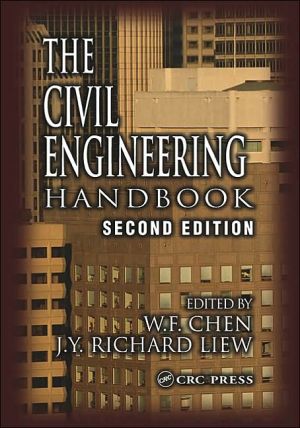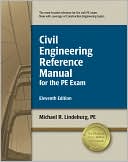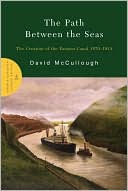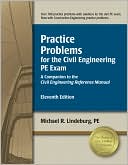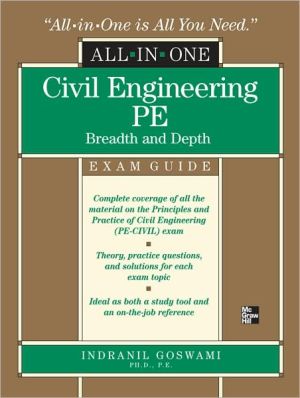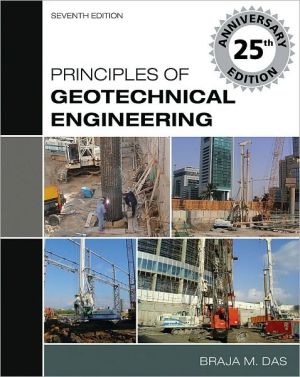The Civil Engineering Handbook
First published in 1995, the award-winning Civil Engineering Handbook soon became known as the field's definitive reference. To retain its standing as a complete, authoritative resource, the editors have incorporated into this edition the many changes in techniques, tools, and materials that over the last seven years have found their way into civil engineering research and practice.\ The Civil Engineering Handbook, Second Edition is more comprehensive than ever. You'll find new, updated, and...
Search in google:
First published in 1995, the award-winning Civil Engineering Handbook soon became known as the field's definitive reference. To retain its standing as a complete, authoritative resource, the editors have incorporated into this edition the many changes in techniques, tools, and materials that over the last seven years have found their way into civil engineering research and practice.The Civil Engineering Handbook, Second Edition is more comprehensive than ever. You'll find new, updated, and expanded coverage in every section. In fact, more than 1/3 of the handbook is new or substantially revised. In particular you'll find increased focus on computing reflecting the rapid advances in computer technology that has revolutionized many aspects of civil engineering. You'll use it as a survey of the field, you'll use it to explore a particular subject, but most of all you'll use The Civil Engineering Handbook to answer the problems, questions, and conundrums you encounter in practice. Booknews This hefty, comprehensive handbook presents information on nearly every aspect of civil engineering, including design techniques, construction methods, instrumentation, material properties, and calculations. Stressing applications, each topic's coverage includes both the fundamentals as well as ready-to-use materials. Traditional as well as new and innovative practices are covered, and modern CAD/CAE tools and approaches are featured throughout. The 67 chapters are divided into eight sections on construction, environmental, structural, geotechnical, surveying, hydraulic, materials, and transportation engineering. The second edition adds three chapters on value improvement methods, the quality of urban runoff, and composite steel-composite structures. Editors Chen (U. of Hawaii) and Liew is (National University of Singapore) have brought together the work of many contributors and have carefully edited and integrated the many components of this reference. Annotation c. Book News, Inc., Portland, OR
Sect. IConstructionIntroduction1Construction Estimating2Construction Planning and Scheduling3Equipment Productivity4Design and Construction of Concrete Formwork5Contracts and Claims6Construction Automation7Value Improvement MethodsSect. IIEnvironmental EngineeringIntroduction8Water and Wastewater Planning9Physical Water and Wastewater Treatment Processes10Chemical Water and Wastewater Treatment Processes11Biological Wastewater Treatment Processes12Air Pollution13Incinerators14Solid Waste/LandfillsSect. IIIGeotechnical EngineeringIntroduction15Soil Relationships and Classification16Accounting for Variability (Reliability)17Strength and Deformation18Groundwater and Seepage19Consolidation and Settlement Analysis20Stress Distribution21Stability of Slopes22Retaining Structures23Foundations24Geosynthetics25Geotechnical Earthquake Engineering26Geo-Environment27In Situ Subsurface Characterization28In Situ Testing and Field InstrumentationSect. IVHydraulic EngineeringIntroduction29Fundamentals of Hydraulics30Open Channel Hydraulics31Surface Water Hydrology32Urban Drainage33Quality of Urban Runoff34Groundwater Engineering35Sediment Transport in Open Channels36Coastal Engineering37Hydraulic Structures38Simulation of Hydraulics and Hydrology39Water Resources Planning and ManagementSect. VMaterials EngineeringIntroduction40Constituents and Properties of Concrete41Durability of Concrete42Special Concrete and Application43Wood as a Construction Material44Structural Steel45Bituminous Materials and MixturesSect. VIStructural EngineeringIntroduction46Mechanics of Materials47Theory and Analysis of Structures48Design of Steel Structures49Cold Formed Steel Structures50Structural Concrete Design51Composite Steel-Concrete Structures52Structural ReliabilitySect. VIISurveying EngineeringIntroduction53General Mathematical and Physical Concepts54Plane Surveying55Geodesy56Photogrammetry and Remote Sensing57Geographic Information SystemsSect. VIIITransportation EngineeringIntroduction58Transportation Planning59Airport Planning and Design60High-Speed Ground Transportation: Planning and Design Issues61Urban Transit62Highway and Airport Pavement Design63Geometric Design64Highway Traffic Operations65Intelligent Transportation Systems66Highway Asset Management67Environmental Considerations during Transportation PlanningAppMathematics, Symbols, and Physical ConstantsIndex
\ From The CriticsThis hefty, comprehensive handbook presents information on nearly every aspect of civil engineering, including design techniques, construction methods, instrumentation, material properties, and calculations. Stressing applications, each topic's coverage includes both the fundamentals as well as ready-to-use materials. Traditional as well as new and innovative practices are covered, and modern CAD/CAE tools and approaches are featured throughout. The 67 chapters are divided into eight sections on construction, environmental, structural, geotechnical, surveying, hydraulic, materials, and transportation engineering. The second edition adds three chapters on value improvement methods, the quality of urban runoff, and composite steel-composite structures. Editors Chen (U. of Hawaii) and Liew is (National University of Singapore) have brought together the work of many contributors and have carefully edited and integrated the many components of this reference. Annotation c. Book News, Inc., Portland, OR\ \
